牛津高中英语模块六Unit 3 Welcome的教学设计
小议译林牛津高中英语选修模块6 Unit3 welcome单元导入的教学
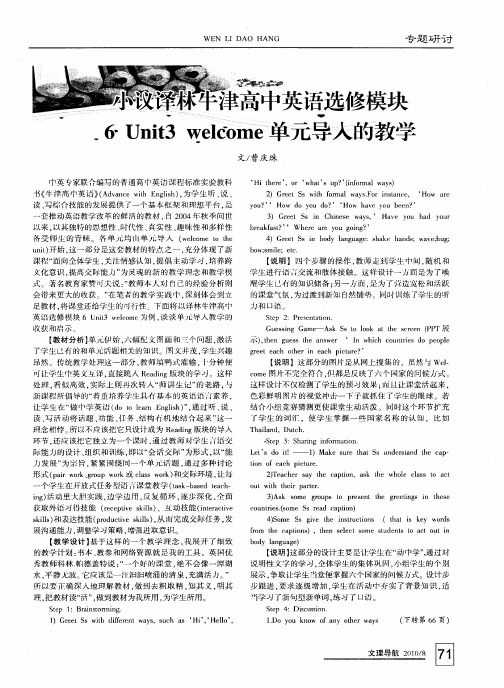
【 明】这部分 的图片足从 网上搜集 的 ,虽然 We 说 l — cm o e图片不完全符合 , 但都足反映 了六个 国家的问候 式 。
这样设计 不仅检测 了学生 的预 习效 果 ; l 让 课堂活起来 , 且
色 彩 鲜 明 图 片 的视 觉 冲击 一 下 子 就 抓 住 了学 生 的 日球 。若 艮 结 合 小 组 竞 赛 猜 测 更 使 课 堂 生 动 活 泼 。 时 这 个 环节 扩 充
醒 学 生 已有 的 知 识 储 备 : 另一 办 面 . 为 了背 造 宽 松 和 活 跃 足 的课 堂 气 氛 , 过 渡 到 新 知 自然 铺 。『 时训 练 了学 生 的听 为 百 j
力 和 口语 。
S e 2:Pr s n ai n. tp e e t to
英语 选修模块 6 U i ecm nt w lo e为例 , 3 谈谈 单兀 导人 教学 的
昂然 。传统教学处理这一 部分 , 教师 填鸭式 灌输 ,卜 分钟便
町让 学 生 巾 英 义 互译 。 接 跳 入 R a ig版 块 的学 习 。这 样 直 edn 处 卿 . 似 高 效 . 际上 则 7 入 “ 讲 生 记 ” 老 路 , 看 实 欠转 师 的 与 新课程所倡 导的“ 重培养学生具有 基_ 的英语语音素养 , 着 奉 让 学 生 在 “ 巾学 英 语 ( o t l r nl h ”通 过 听 、 、 做 d o e n E gi ) , a s 说 渎 、 活 动 将 话 题 、 能 、 务 、 构 有 机 地 结 合 起 来 ” 一 写 功 任 结 这 理 念 相 悖 . 以不 应 该 把 它 只设 计 成 为 R aig版块 的导 人 . 所 edn 环 节 . 应 该把 它 独 立 为 一 个 课 时 . 过 教 师对 学 生 语 交 还 通 际 能 力 的设 计 、 织 和 训 练 , 以“ 话 交 际 ” 形 式 , “ 组 即 会 为 以 能 力 发 展 ” 宗 旨 , 紧 罔 绕 一 个 单 话 题 , 过 多 种 讨 论 为 紧 通 形 式 (arw r、ru ok或 c s w r ) pi ok go p w r l s ok 和交 际 环境 , 每 a 让
牛津英语模块6Unit3welcomeandreading公开课教学

Wedding ceremonies in Korea
What made Peter surprised at the wedding reception in Korea?
They had a live hen and a rooster as a part of the wedding ceremony.
What is permitted and what is prohibited at the wedding reception in Brunei?
In Japan or Korea, people __b_o_w____ to each other when they meet.
When in Rome, do as the Romans do.
TTaasFskaks1t1:r:FFeaaasdstitnrrgeeaaddiningg
1. How many people are involved in this conversation? Who are they? Three. They are Mali , Peter and Waled.
In South America, you can expect to be _h_u_g_g__e_d___ when you meet someone.
选修6Unit 3同步教案(Welcome)

英语牛津译林版选修6Unit 3同步教案(Welcome)Module 6 Unit 3 Understanding each otherPeriod 1 Welcome to the unitTeaching objectivesBy the end of this period,Ss will be able to:Language1describe festivals2describe customs3compare some social behaviors4 form an appropriate attitude toward different cultures and customsSkills & strategies4read an internet chat room dialogue and a travel brochure to gain much knowledge of different cultures and traditions of different ethnic groups5listen to a conversation about showing foreign visitors around a city and others to get more information about cultural customs6discuss different cultures, traditions and taboosCulture & morals7learn about cultural differences8get to know about taboos and customs in different countries9learn to deal with the taboos and customs in different occasions10discuss and find out the traditions and taboos in different cultures and some original reasons11get interested in learning about the cultural differences in different ethnic groupsKeys & puzzlesHow to get all the Ss involved in the group discussion and pair-workTeaching approaches1 Task-based Teaching Approach (TBT)2 Situational Teaching Approach (ST)3 Communicative Language Teaching Approach (CLT)Teaching aidsa multimedia courseware and a blackboardTeaching proceduresIn generalIn Welcome to the unit, six pictures and three questions are all Ss can access to in the textbook. However, Ss are supposed to do a lot of talking and discussing about pe ople’s different ways of greeting each other in different countries and compare some different daily behaviors and different festivals of the east and the west by gaining some information shown through multimedia.First, two Ss, as the duty reporters, give a performance about different Chinese people’s greetings to different people, such as their superiors and their peers, and by asking Ss to guess and give explanations, the teacher will lead into the different greetings in different countries shown in the six pictures and add something about the pictures. In order to stimulate the Ss’ interest, the teacher designs a humourous story about ‘cultural shock’, brainstorm the Ss and discuss how to avoid this phenomenon together. After their discussion and expressing their own opinions about the possible problems that might be caused by these differences, the Ss are expected to take part in the discussion about table manners and further think on the topic why more and more foreigners are learning how to use chopsticks. Apart from delicious Chinese food, they also like China not only because of its beautiful scenery, especially so many World Heritages of nature and culture, but its rich and colorful cultures and customs. The teacher can try to elicit more, arousing t he Ss’s patriotism. Next the Ss are to look at some pictures and gain some information about Halloween and Qingming Festival through multimedia, and after discussion, the Ss are supposed to get the general idea of cultural differences.Then the Ss are asked to have a competition on the topic of Chinese young people’s craze about celebrating Christmas Day. Through heated argument they are expected to form an appropriate attitude towards different cultures and customs. At last, Ss are ask to summarize the main contents and consolidate the new words and expressions about cultures and customs in this period. At the end of the period, Ss are encouraged to choose one of the three topics they have discussed to write a composition according to the results they’ve go t. In a word, the whole lesson is a big discussion involving all the Ss brainstorming, discussing in groups or pairs, and competing, which will hopefully pave the way for the learning in the section of Reading.(通过同学表演审视自己平时的交际(问候)方式→设计关于‘文化休克’的风趣小故事,让学生进一步了解东西方不同文化背景下的见面问候方式的不同→思考并讨论怎样对待这些不同的方式→讨论东西方不同的餐桌礼仪→了解并比较西方的万圣节和中国的清明节→就中国许多年轻人热衷于过圣诞节开展辩论赛→通过图片展示和归纳总结本次课所接触的新鲜词汇和表达方式→布置作业)In detailStep 1 Warming up (5 minutes)1. Have two Ss, as the duty reporters to give a performance about different Chinesepeople’s greetings to different people, such as their superiors and their peers and ask their classmates to guess and give explanations. (3 minutes)2. The teacher gives a humourous story about ‘cultural shock’ to stimulate theSs’ interest, brain storm the Ss and discuss how to avoid this phenomenon together.(3 minutes)3. The teacher can try to elicit more. For example, just as the two Ss performed,if we meet a friend in the street, we often say: “Hi, have you had your meal”or “Where are you going”. When it is the case of two gentlemen, they tend to shake hands. However, in western countries, the above questions are just questions, not greeting at all. They may think you’re inviting them to dinner if you ask about their meals. Usually, they’ll j ust give each other a smile or greet with a “Hi.”. They’ll shake hands only in some formal situations. By the way, Westerners can leave a party or meeting halls without a formal conge, nor should they shake hands with every attendee like most of us will do here.Now let’s see some other foreigners greet each other. ( 2 minutes)(See courseware)Step 2 Discussion (15 minutes)1. Ask Ss to talk about the six pictures and require them to try to remember these different greetings and the teacher can add more. (3 minutes)2. Then have the first group discussion about If someone greets you in these ways what will you do then (3 minutes)3. The teacher can guide the Ss to our state leaders’ different ways of greeting their different heads while visiting different countries, making the Ss get to understand and form appropriate ideas and ways to communicate with different people in different cultures and customs. Remember this saying(write down on the Bb):Do in Rome as the Romans do. And ask the Ss to form a habit of taking notes while discussing and write a composition about the result of the discussion afterclass. (1 minute)Write down the title on the Bb An appropriate attitude to different greetings4. Then Ss share their ideas and the teacher gives assessment. (3 minutes)5. Now, come to the section of table manners by showing some pictures.(see courseware) If the Ss don’t know how to use a knife and fork, the teacher will tell them: when westerners eat, their bowls and plates cannot leave the table. Food should be cut by knife to fit into the mouths. Of course your mouth cannot touch the plates or bowls. So the regular process is like this. You cut your steak on the plate with a knife and fork and send the meat cube into the mouth with the fork and nothing will be returned but the fork alone. (2 minutes)6. Then discuss in pairs Why more and more foreigners are learning how to use chopsticks and what it implies. (2 minutes) Then the Ss give their opinions and the teacher will give proper assessment and add something necessary, like this: foreigners not only like Chinese delicious and healthy food but also its splendid national culture, and they even like China not only because of its beautiful scenery, including so many world heritages of nature and culture, but also its higher and higher international standing, arousing the Ss’ sense of taking pride in our motherland. (4 minutes)Write down the title on the Bb: Why foreigners long to learn to use chopsticks Step 3 Further Discussion (10 minutes)1. Cultural differences exist not only in daily life but in some traditional festivals. Ss will look at some pictures(see courseware)to learn about Halloween in the West and Chinese Qingming Festival. When showing pictures the teacher will remind Ss to take care not to cause forest fire if they go grave-sweeping, burning joss sticks and fireworks.(5 minutes)2. Then group work for discussion. Ss are to choose one or two to prepare from the following questions(see courseware),then share their opinions. The teacher will give some help and his own ideas. (5 minutes)Step 4 Competition (10 minutes)1. We Chinese people are tolerant and receptive to different cultures. Now let’sfirst have a discussion. (3 minutes)2. Then hold a debate about how to deal with Christmas in China. (7 minutes) (see courseware). Ss are to be divided into two parts, one the supporter, the other the opposite. Each part will be given 3 minutes in total. One volunteer, as the judge, will give a fair assessment and a summary.3. The teacher will declare like this: We are supposed to hold an English party on the coming Christmas Day. Every student shall make full preparations. Try our best to spend less but have the party both as an entertaining evening and a big meal for learning English.Write down the title on the Bb How to celebrate Christmas Day in ChinaStep 5 Consolidation1. The Ss are asked what they learn from this period and summarize the main contentsfor this part.2. Some pictures are represented to ar ise the Ss’ memor ies to consolidate some new vocabulary.Step 6 Homework (2 minutes)1. Choose one of the following titles to write a composition on the results of your discussion.1)An appropriate attitude to different greetings2) Why foreigners long to learn to use chopsticks3) How to celebrate Christmas Day in China2.Preview Reading by going through all the relative words and expressions in thewordlist.FeedbackMineIn the whole class, the Ss have shown great interest in learning about cultural differences and cross-culture communicating. First, the two Ss’ performance served as an active lead-in. And the first high tide came when they discussed foreigners’ using chopsticks, and the second high tide is when they see a humorous story about ‘cultural shock’ and they have a hot discussion about how to avoid this phenomenon. The real climax was the debate competition on Christmas Day. Christmas Day is quite familiar to Ss and the competition aroused their enthusiasm. But the discussion about Halloween and Qingming Festival was a little awkward silence. I should have given Ss some background information about the two festivals. So, for me, how to make a discussion heated and fruitful is something worth exploring all the time.Another achievement is that the effect of class teaching has gone beyond the limit of classrooms. Ss’ initiative of autonomous study has shown in their homework. In a composition titled Why foreigners long to learn to use chopsticks, some student wrote like this: Using chopsticks is a kind of complex and fine movement involving more than 30 joints and 50 muscles from the fingers to the palm, the wrist, the arm even to the shoulder. It shows that Ss now have a large range of knowledge gained in various ways. And this promotes me to decide to spend one more hour a day learning more.I think, although courseware is used, the design of writing on the Bb is also necessary. We should realize the organic combination of courseware and Bb. My Writing on the Bb is like this: the left part of the Bb is taken up by the screen; the central, the title, Understanding each other Welcome to the unit, the saying Do in Rome as the Romans do and the above three titles for composition; the right part, some new and key words.In this period, I gave each small step an exact time in order to leave more time to the Ss, and I got a satisfactory result.课后作业单项填空1.Tomorrow the mayor is to________a group of Canadian businessmen on a tour of the city.A.accompany B.supportC.associate D.assist2.Doctors are doing research to find out what happens physically whenpeople________smoking.A.quit B.declineC.depart D.reserve3.We must learn to________the new life when going abroad.A.adapt B.adapt toC.adapt with D.adapt in4.There is no point________improving public transport unless we can pay for it.A.advocating B.advocatedC.to advocate D.advocate5.The baby was playing on the carpet________by all kinds of toys.A.surrounding B.surroundedC.surrounds D.having surrounded6.You see the lightning________it happens, but you hear the thunder later.A.the instant B.for an instantC.on the instant D.in an instant7.By the time Jack returned home from England,his son________from college.(2011·辽宁,34)A.graduated B.has graduatedC.had been graduating D.had graduated8.We can’t accurately________ what will happen in the future.A.debate B.speakC.analyze D.predict9.—I’m just th inking of the t est ’m afraid I can’t pass this time.—________.A.Go ahead B.Good luckC.No problem D.Cheer up10.—Why didn’t you go to see the play—________ the whole story,I decided not to see itA.Being told B.I had been toldC.I was told D.Having been told【参考答案】单项选择2.A 3.B 4.A 5.B 6.A 7.D 8.D 9.D 10.D。
牛津高中英语模块六Unit3Welcome的教学设计
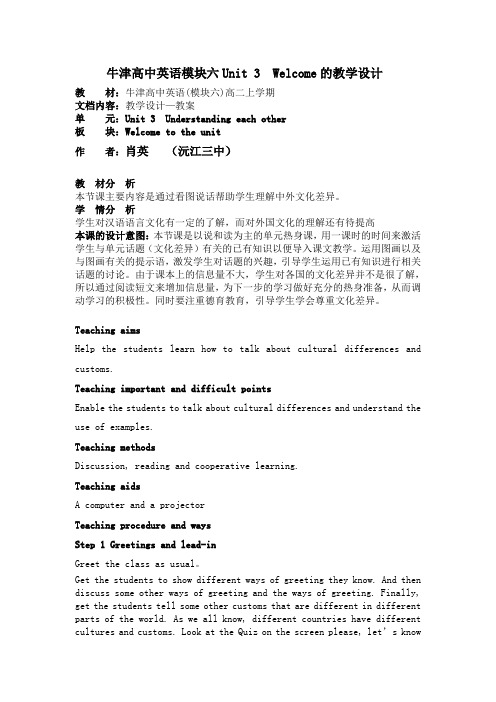
牛津高中英语模块六Unit 3 Welcome的教学设计教材:牛津高中英语(模块六)高二上学期文档内容:教学设计—教案单元:Unit 3 Understanding each other板块:Welcome to the unit作者:肖英(沅江三中)教材分析本节课主要内容是通过看图说话帮助学生理解中外文化差异。
学情分析学生对汉语语言文化有一定的了解,而对外国文化的理解还有待提高本课的设计意图:本节课是以说和读为主的单元热身课,用一课时的时间来激活学生与单元话题(文化差异)有关的已有知识以便导入课文教学。
运用图画以及与图画有关的提示语,激发学生对话题的兴趣,引导学生运用已有知识进行相关话题的讨论。
由于课本上的信息量不大,学生对各国的文化差异并不是很了解,所以通过阅读短文来增加信息量,为下一步的学习做好充分的热身准备,从而调动学习的积极性。
同时要注重德育教育,引导学生学会尊重文化差异。
Teaching aimsHelp the students learn how to talk about cultural differences and customs.Teaching important and difficult pointsEnable the students to talk about cultural differences and understand the use of examples.Teaching methodsDiscussion, reading and cooperative learning.Teaching aidsA computer and a projectorTeaching procedure and waysStep 1 Greetings and lead-inGreet the class as usual。
Get the students to show different ways of greeting they know. And then discuss some other ways of greeting and the ways of greeting. Finally, get the students tell some other customs that are different in different parts of the world. As we all know, different countries have different cultures and customs. Look at the Quiz on the screen please, let’s knowmore about cultural differences in different countries.1) In Western count ries, it’s unusual to give tips. (No)2) Westerners tend to avoid using13. (Yes)3) Nodding your head up and down always means yes. (No)4) Usually, one should never give a clock as a gift in China. (Yes)5) Never point to anything with your foot in Vietnam. (Yes)6) You can pass something to an older person with one hand in Korea.(No)7) In Canada, it’s OK to arrive early if you are invited to someone’shouse? (No)Write the following names of countries on the blackboard.China, Japan, USA, Thailand, South America, the Middle East, Dutch (设计意图)本环节先从单元话题入手,让学生从简单的QUIZ中了解各国在日常生活中有哪些基本的文化差异,不至于在以后与外国人打交道产生误解,造成尴尬的局面。
英语牛津译林Unit 同步教学设计(Welcome)
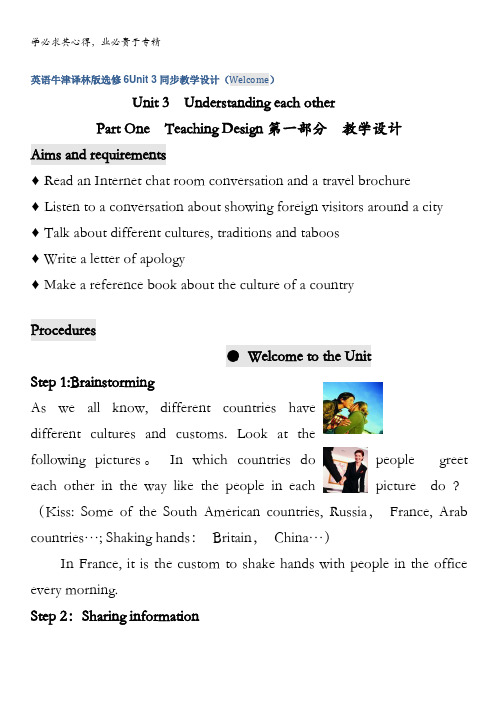
英语牛津译林版选修6Unit 3同步教学设计(Welcome)Unit 3 Understanding each otherPart One Teaching Design第一部分教学设计Aims and requirements♦ Read an Internet chat room conversation and a travel brochure♦ Listen to a conversation about showing foreign visitors around a city♦ Talk about different cultures, traditions and taboos♦ Write a letter of apology♦ Make a reference book about the culture of a countryProcedures●Welcome to the UnitStep 1:BrainstormingAs we all know, different countries havedifferent cultures and customs. Look at thefollowing pictures。
In which countries do people greet each other in the way like the people in each picture do?(Kiss: Some of the South American countries, Russia,France, Arab countries…; Shaking ha nds:Britain,China…)In France, it is the custom to shake hands with people in the office every morning.Step 2:Sharing informationLook at the following pictures and read the captions under them .Can you match the ways of greeting with the countries?Country/Area Ways of greetingHolland putting their hands together and bowing slightly Thailand kissing each other on one cheek and then the otherThe USA greeting each other by touching nosesSouth America hugging each otherThe Middle East shaking hands with each otherJapan bowing to each otherWhat about an Arab and a Japanese meeting for the first time?As a Chinese,if you are not familiar with greetings from other countries,what might happen?(Maybe we would feel embarrassed;we might be involved in awkward situations like…)Step 3: Discussion1.Do you know of any other ways of greeting that people around the world use?2.People in different countries greet each other in different ways。
牛津译林版高中英语模块6 Unit 3 Section Ⅰ Welcome to the unit

1.Can the British and Americans understand one another easily?
2.In which aspects do the British English and the American English differ?
The United Kingdom and the United States share many common values and speak basically the same language. But what are some of the differences that tourists and expatriates(侨民) from the UK notice when they visit or live in America?
Schools are run very differently in the UK and in the USA. In the UK, children usually start school at the age of 5 and leave at 16 or they can complete one or two extra years of schooling and leave at the age of 17 or 18. The school years runs from early September to late July with short “half term〞 breaks in between. Students wear school uniforms to identify the school they attend. Unlike American schools, where children “graduate〞 at the end of their school career, British school children simply leave. A person is referred to as a “school leaver〞 rather than as a “high school graduate〞. Graduation is reserved for the time when students finish their university course.
教案:Unit 3 Welcome
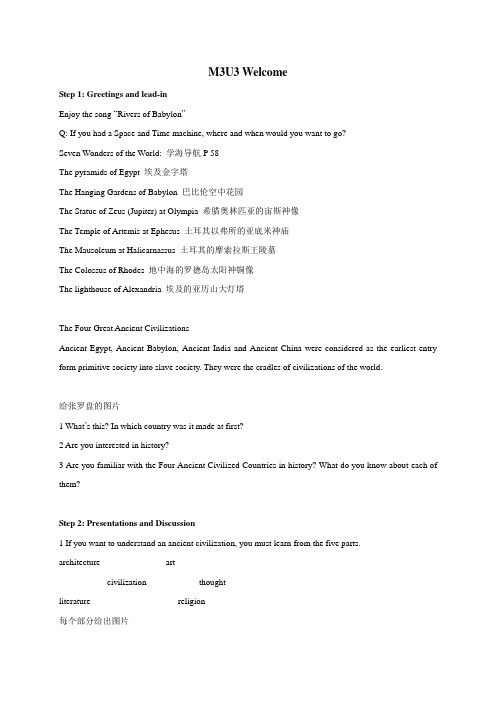
M3U3 WelcomeStep 1: Greetings and lead-inEnjoy the song “Rivers of Babylon”Q: If you had a Space and Time machine, where and when would you want to go?Seven Wonders of the World: 学海导航P 58The pyramids of Egypt 埃及金字塔The Hanging Gardens of Babylon 巴比伦空中花园The Statue of Zeus (Jupiter) at Olympia 希腊奥林匹亚的宙斯神像The Temple of Artemis at Ephesus 土耳其以弗所的亚底米神庙The Mausoleum at Halicarnassus 土耳其的摩索拉斯王陵墓The Colossus of Rhodes 地中海的罗德岛太阳神铜像The lighthouse of Alexandria 埃及的亚历山大灯塔The Four Great Ancient CivilizationsAncient Egypt, Ancient Babylon, Ancient India and Ancient China were considered as the earliest entry form primitive society into slave society. They were the cradles of civilizations of the world.给张罗盘的图片1 What’s this? In which country was it made at first?2 Are you interested in history?3 Are you familiar with the Four Ancient Civilized Countries in history? What do you know about each of them?Step 2: Presentations and Discussion1 If you want to understand an ancient civilization, you must learn from the five parts.architecture artcivilization thoughtliterature religion每个部分给出图片2 Look at the four pictures and discuss the following questions:1) Do these pictures have something in common?2) If so, please describe it with some adjectives, as many as you can.magnificent, well-designed, ancient, famous, distantStep 3: DiscussionNow you have known much about magnificent structures. From the four pictures we discuss above we know that civilization has a variety of elements. And it is necessary for you to learn more about it. Here let’s have a discussion of the following questions.1 Just now we talked about some ancient civilizations. What can you learn from these?2 What other ancient civilizations do you know about?3 Have you ever been on a cultural expedition? If so, please tell your stories.4 Do you think it is important to protect cultural heritage? Why or why not? Do you have any suggestions on how to protect it?Step 4: Summary and homeworkWe have discussed about the magnificent ancient civilizations, and all of you have done a good job. I’m so happy with you. At the end of this period, I would like you to know the importance of protecting cultural heritage, because of its valuable history including the economy, the politics, and the living style of the past. After class, please collect more information about the ancient civilizations worldwide if you feel interested in it.。
牛津译林版高中英语模块6 Unit 3 Welcome 教学设计

_______________________________________________________________________
Ⅵ.Questions.
Well,I think it’s just like the way we …
Sorry I don’t think so./ It’s bad manners/ rude/not acceptable to…
_______________________________________________________________________
_______________________________________________________________________
_______________________________________________________________________
2. Do Chinese people use such gestures?
3Help students form correct attitudes towards foreign cultures.
Ⅱ.Important Difficult Point:
Improve students’ speaking and thinking ability.
Ⅲ.Form of Activities:
Unit 3 Welcome教学设计
Ⅰ. Learning Aims:
1Enable students to get a general idea of different ways of greeting each other in different countries.
牛津译林版高中英语模块3 Unit 3 Welcome to the unit 教学设计
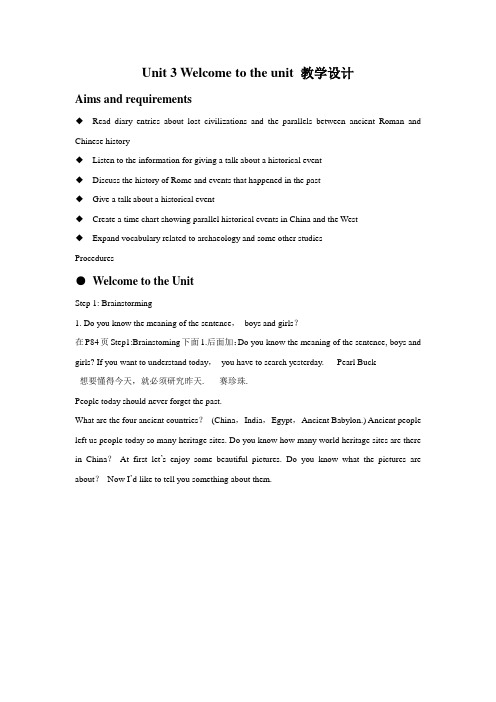
Unit 3 Welcome to the unit 教学设计Aims and requirements◆Read diary entries about lost civilizations and the parallels between ancient Roman and Chinese history◆Listen to the information for giving a talk about a historical event◆Discuss the history of Rome and events that happened in the past◆Give a talk about a historical event◆Create a time chart showing parallel historical events in China and the West◆Expand vocabulary related to archaeology and some other studiesProcedures●Welcome to the UnitStep 1: Brainstorming1. Do you know the meaning of the sentence,boys and girls?在P84页Step1:Brainstoming下面1.后面加:Do you know the meaning of the sentence, boys and girls? If you want to understand today,you have to search yesterday. --- Pearl Buck想要懂得今天,就必须研究昨天. --- 赛珍珠.People today should never forget the past.What are the four ancient countries?(China,India,Egypt,Ancient Babylon.) Ancient people left us people today so many heritage sites. Do you know how many world heritage sites are there in China?At first let’s enjoy some beautiful pictures. Do you know what the pictures are about?Now I’d like to tell you something about them.China has now 35 heritage sites,with 24 cultural sites,six natural sites and five mixed. (The Great Wall,the Temple of Heaven,the Forbidden City,the Summer Palace,the Potala Palace,Jiuzhaigou Valley Scenic and Historic Interest Area,Classical Gardens of Suzhou,Mount Huang,Mogao Caves and so on)Imperial City,the administrative andstretching in the east-west axis 1,700600. Only a small portion of the premises is taken by halls。
Unit 3 welcome教案

Teaching planUnit 3 Looking good, feeling goodPeriod 1 Welcome to the unitTeaching aims:(1) Make students pay attention to their health, and how to keep healthy.(2) Get the Ss to improve oral English by talking about the pictures.Important points & difficult points:(1) Students are expected to express their own opinions by comparing the importance of beauty and health.(2) Encourage students to speak freely.Teaching methods:Individual study methodTeaching aids:Multi-media; blackboardProcedure:Step 1 Lead-inLook at pictures about some famous people, and think of the question:1) Do you think they look good?2) What do you think has made them so attractive that they are in people’s memory allthe time?Some questions about your yourself:1) Do you think appearance plays an important part in your life?2) In you opinion, is a person’s ability judged by their appearance?Step 2 Self-study InstructionsLook at the four pictures and have a pair work.Choose one picture, and have a free talk.1). Who is the person?2). The reason why he/she does as the picture shows3). Give some details about the picture.(An example:Jane is a high school student and she is extremely happy, because she has been admitted to university. Tonight her parents will hold a party to celebrate her success and achievements. All their friends and relatives are invited to share her happiness. However, now she is at a loss about the clothes she is going to wear tonight. She is confident about everything except her weight. She always worries about being too fat. At this moment, she has spent at least half an hour selecting clothes without success.)Step 3 Talk about questions(1) Do you think we can change our appearance by wearing different clothes?(2) Which do you think is more important, eating well or doing exercises? Step 4 Further discussionWhat do you do to keep yourself looking good and feeling good?Step 5 Homework1. Preview the reading text.2. Write a passage about “health and beauty”.。
Unit3Welcome教学设计-2024-2025学年初中英语牛津译林版八年级上册

本课针对的是2024-2025学年初中英语牛津译林版八年级上册的学生。该年级的学生已经掌握了基本的英语语法和词汇,具备一定的英语听说读写能力。他们在学习过程中能够积极发言,参与课堂活动,表现出对英语学习的热情。然而,部分学生在语言表达上还存在一定困难,对于一些复杂句型和语法点的掌握尚需加强。
3. 随堂测试:
在课程结束后,我会进行一次随堂测试,以检验学生对本节课内容的掌握程度。测试内容将涵盖本节课的主要知识点,包括国家名称、首都、一般现在时态的运用等。通过测试,我可以了解学生的学习效果,为下一步的教学提供依据。
4. 作业评价:
对于学生提交的课后作业,我会认真批改,并给出详细的评价和反馈。我会关注学生作业中的亮点,鼓励他们继续保持;同时,针对作业中出现的问题,我会给予针对性的指导,帮助他们改进。
3. 例题三:阅读理解题
题目:Read the passage and answer the question.
Passage: John is from China. He lives in Beijing with his parents. His father is a doctor, and his mother is a teacher.
5. 教师评价与反馈:针对学生在课堂上的整体表现,我会进行总结性评价,给出中肯的建议和鼓励。对于表现优秀的学生,我会提出更高的要求,激发他们继续努力;对于表现有待提高的学生,我会关注他们的进步,给予耐心指导和关爱,帮助他们建立自信,提高学习兴趣。
典型例题讲解
1. 例题一:选择题
题目:Which of the following sentences is correct?
7. 课堂小结(5分钟)
在课堂即将结束时,我会对本节课的主要内容进行简要回顾,并强调一般现在时态的用法。同时,我会提醒学生课后复习,为下一节课做好铺垫。
Book6U3教案课时1Welcometotheunit
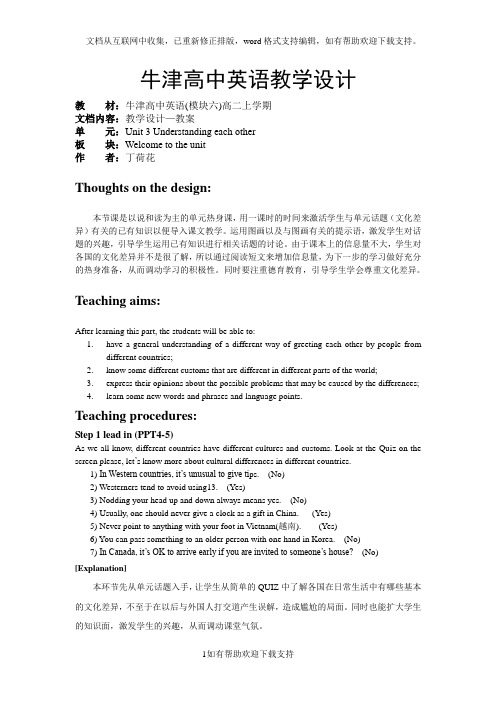
牛津高中英语教学设计教材:牛津高中英语(模块六)高二上学期文档内容:教学设计—教案单元:Unit 3 Understanding each other板块:Welcome to the unit作者:丁荷花Thoughts on the design:本节课是以说和读为主的单元热身课,用一课时的时间来激活学生与单元话题(文化差异)有关的已有知识以便导入课文教学。
运用图画以及与图画有关的提示语,激发学生对话题的兴趣,引导学生运用已有知识进行相关话题的讨论。
由于课本上的信息量不大,学生对各国的文化差异并不是很了解,所以通过阅读短文来增加信息量,为下一步的学习做好充分的热身准备,从而调动学习的积极性。
同时要注重德育教育,引导学生学会尊重文化差异。
Teaching aims:After learning this part, the students will be able to:1.have a general understanding of a different way of greeting each other by people fromdifferent countries;2.know some different customs that are different in different parts of the world;3.express their opinions about the possible problems that may be caused by the differences;4.learn some new words and phrases and language points.Teaching procedures:Step 1 lead in (PPT4-5)As we all know, different countries have different cultures and customs. Look at the Quiz on the screen please, let’s know more about cultural differences in different countries.1) In Western countries, it’s unusual to give ti ps. (No)2) Westerners tend to avoid using13. (Yes)3) Nodding your head up and down always means yes. (No)4) Usually, one should never give a clock as a gift in China. (Yes)5) Never point to anything with your foot in Vietnam(越南). (Yes)6) You can pass something to an older person with one hand in Korea. (No)7) In Canada, it’s OK to arrive early if you are invited to someone’s house?(No) [Explanation]本环节先从单元话题入手,让学生从简单的QUIZ中了解各国在日常生活中有哪些基本的文化差异,不至于在以后与外国人打交道产生误解,造成尴尬的局面。
牛津英语welcome说课稿
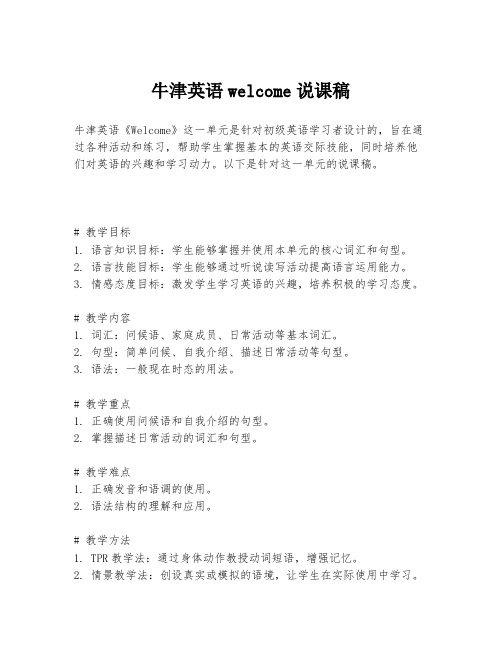
牛津英语welcome说课稿牛津英语《Welcome》这一单元是针对初级英语学习者设计的,旨在通过各种活动和练习,帮助学生掌握基本的英语交际技能,同时培养他们对英语的兴趣和学习动力。
以下是针对这一单元的说课稿。
# 教学目标1. 语言知识目标:学生能够掌握并使用本单元的核心词汇和句型。
2. 语言技能目标:学生能够通过听说读写活动提高语言运用能力。
3. 情感态度目标:激发学生学习英语的兴趣,培养积极的学习态度。
# 教学内容1. 词汇:问候语、家庭成员、日常活动等基本词汇。
2. 句型:简单问候、自我介绍、描述日常活动等句型。
3. 语法:一般现在时态的用法。
# 教学重点1. 正确使用问候语和自我介绍的句型。
2. 掌握描述日常活动的词汇和句型。
# 教学难点1. 正确发音和语调的使用。
2. 语法结构的理解和应用。
# 教学方法1. TPR教学法:通过身体动作教授动词短语,增强记忆。
2. 情景教学法:创设真实或模拟的语境,让学生在实际使用中学习。
3. 合作学习:通过小组活动,促进学生之间的交流和合作。
# 教学过程1. 导入:通过播放一段简短的英语问候视频,激发学生兴趣。
2. 呈现:展示本单元的核心词汇和句型,通过图片、动作等辅助教学。
3. 练习:通过角色扮演、对话练习等形式,让学生实践所学知识。
4. 应用:设计一个实际场景,让学生运用所学知识进行交流。
5. 作业:布置相关的听说读写练习,巩固课堂所学。
# 教学评价1. 形成性评价:通过课堂观察、小组讨论等方式,了解学生的学习情况。
2. 总结性评价:通过测试、作业等方式,评估学生对单元知识的掌握程度。
# 教学反思课后,教师应根据学生的反馈和表现,反思教学方法和内容,不断调整和优化教学策略。
通过上述教学设计,学生不仅能够掌握基本的英语交际技能,还能在轻松愉快的氛围中提高学习英语的兴趣和动力。
- 1、下载文档前请自行甄别文档内容的完整性,平台不提供额外的编辑、内容补充、找答案等附加服务。
- 2、"仅部分预览"的文档,不可在线预览部分如存在完整性等问题,可反馈申请退款(可完整预览的文档不适用该条件!)。
- 3、如文档侵犯您的权益,请联系客服反馈,我们会尽快为您处理(人工客服工作时间:9:00-18:30)。
牛津高中英语模块六Unit 3 Welcome的教学设计教材:牛津高中英语(模块六)高二上学期文档内容:教学设计—教案单元:Unit 3 Understanding each other板块:Welcome to the unit作者:肖英(沅江三中)教材分析本节课主要内容是通过看图说话帮助学生理解中外文化差异。
学情分析学生对汉语语言文化有一定的了解,而对外国文化的理解还有待提高本课的设计意图:本节课是以说和读为主的单元热身课,用一课时的时间来激活学生与单元话题(文化差异)有关的已有知识以便导入课文教学。
运用图画以及与图画有关的提示语,激发学生对话题的兴趣,引导学生运用已有知识进行相关话题的讨论。
由于课本上的信息量不大,学生对各国的文化差异并不是很了解,所以通过阅读短文来增加信息量,为下一步的学习做好充分的热身准备,从而调动学习的积极性。
同时要注重德育教育,引导学生学会尊重文化差异。
Teaching aimsHelp the students learn how to talk about cultural differences and customs.Teaching important and difficult pointsEnable the students to talk about cultural differences and understand the use of examples.Teaching methodsDiscussion, reading and cooperative learning.Teaching aidsA computer and a projectorTeaching procedure and waysStep 1 Greetings and lead-inGreet the class as usual。
Get the students to show different ways of greeting they know. And then discuss some other ways of greeting and the ways of greeting. Finally, get the students tell some other customs that are different in different parts of the world. As we all know, different countries have different cultures and customs. Look at the Quiz on the screen please, let’s knowmore about cultural differences in different countries.1) In Western count ries, it’s unusual to give tips. (No)2) Westerners tend to avoid using13. (Yes)3) Nodding your head up and down always means yes. (No)4) Usually, one should never give a clock as a gift in China. (Yes)5) Never point to anything with your foot in Vietnam. (Yes)6) You can pass something to an older person with one hand in Korea.(No)7) In Canada, it’s OK to arrive early if you are invited to someone’shouse? (No)Write the following names of countries on the blackboard.China, Japan, USA, Thailand, South America, the Middle East, Dutch (设计意图)本环节先从单元话题入手,让学生从简单的QUIZ中了解各国在日常生活中有哪些基本的文化差异,不至于在以后与外国人打交道产生误解,造成尴尬的局面。
同时也能扩大学生的知识面,激发学生的兴趣,从而调动课堂气氛。
Step2: PresentationsPlease turn to page 33.Do you know how people greet each other in these countries? Please work in groups of three to show the ways of greeting, one explains, the other two show us.Look at the pictures. Besides theses ways, do you know of any other ways of greeting that people around the world use?Look at the pictures on the screen.In which countries do people greet each other in the way like the people in each picture do?Match the ways of greeting with the countries?Country/Area Ways of greetingNetherlands putting their hands together and bowing slightly Thailand kissing each other on one cheek and then the other South America greeting each other by touching nosesThe Middle East hugging each other(设计意图)根据教材编写的要求先通过直观观察四幅画来了解四个不同的国家各自的问候方式,学生分组讨论交流,然后表达自己的思想,这样可以学会与他人合作,共享学习成果,并练习了口语,大大激发了学生的学习兴趣。
Step 3 Reading1. Read a passage and know more about the different greeting ways mentioned above.Reading material:The way that people greet each other differs from one country to another, but all greetings are meant to show friendship and respect. In Japan, whether meeting someone for the first time or seeing an old friend, people usually greet each other with a bow. In Thailand, the custom is to put one’s hands together at the chest or in front of the face, with the head bowed. In Latin countries, women often greet each other with an embrace, putting their cheeks together while exchanging greetings. In France, the way to greet friends is with a kiss on both cheeks. But possibly the most unusual way to greet a friend is the one used by Eskimos in Alaska—an enthusiastic rubbing of noses! More and more, however, the hand—shake is becoming the most popular greeting around the world. The handshake got its start in the Middle Ages, when all strangers were seen as possible enemies. When two men who didn’t know each other met on a road, they immediately pulled out their weapons. When they were satisfied that the other person was not an enemy, they would put their weapons away and hold out their hands in a gesture of friendship. While they were talking, they often maintained the handshake until they were sure they could trust the other person. Variations of the handshake have developed over the years. In European countries, the handshake has become so popular that it is used almost every time people get together—sometimes several times a day with the same person. In Europe, people take each other’s hands gently and don’t move them as much as in other parts of the world. In Arabic countries, men usually don’t release the handshake until many greetings have been exchanged. In the United States, the handshake is used when meeting people for the first time or when greeting people on importantoccasions. The American handshake is usually a very strong one. Some people even think it’s too strong.. Also, Americans move their hands up and down more than Europeans do. But whatever greeting is used—a handshake, a bow, or an embrace—we can all recognize and understand a gesture of friendship.T or F questions:1. Greetings are meant to show friendship and respect.2. Possibly the most unusual way for people to greet each other is to put one’s hands together at the chest.3. Handshake was first used in the Middle Ages.4. In the United States, people shake hands when they meet important people.5. The Europeans shake hands gently.2. Read another short passage about greetings and answer the following questions.What do Americans/the British/Australians like doing to show respect?When it comes to the first impression, a proper greeting is of the utmost importance. Before you group together all English-speaking people, remember there are many differences greeting manners between various countries. For example, Americans like a strong handshake that shows respect, as well as a simple greeting, ie. ‘Hello, nice to meet you’. Or ‘Hi, my name is John.’ On the contrary, the British prefer a brief but firm handshake associated with a formal greeting such as ‘Good morning, Mr Blair. How are you?’ Australians also differ with people commonly preferring a simple ‘G’ day (Good day) in casual situations. Whether you are introducing yourself to others or seeing an old friend, it is important to use the proper greeting according to the different cultures and situations.(设计意图)按照教材上来上这节课,课堂容量会太小,通过设计阅读这一环节,帮助学生增加与本课有关的知识,引导学生在上一个新的话题时,可以通过阅读来增加信息,同时有机地将话题讨论与阅读相结合。
